Update 2/13/2012: LSI WarpDrive SLP-300 Enterprise PCIe SSD Review
The LSI WarpDrive SLP-300 is an enterprise-class SSD solution that leverages the x8 PCIe expansion slot in a server or desktop. With features like 300GB of SLC flash, six SF-1500 controllers, and a SATA6 533Mhz LSI RAID controller tying it all together, this card promises extremely high transfer speeds, extremely low latency, and an extremely high high price tag. LSI promises up to 1,400MB/s sustained throughput, .5 microsecond seek time, 240,000 4K read IOPS, and 200,000 4K IOPS for the low, low MSRP of $11,500 ($7700 street), which puts it firmly out of reach of most power users. For its intended audience though, it’s a steal.
The main target for the WarpDrive is IO intensive server or workstation applications, like high traffic websites, databases, and video encoding, all of which require high throughput and more importantly low latency. Large websites serving thousands of pages per second require an enormous amount of IOPS, as do the database’s powering those sites. While raw throughput speeds do matter for these operations, it’s the low latency that really makes the difference. If a web page takes 300ms to be retrieved from a storage situation, then that’s at least a 300ms delay for the page viewer. In addition, those page hits can start piling up, causing slower and slower disk access. LSI claims (using its TCO tool) that if you compare the Warpdrive vs a standard storage solution composed of 15k 73GB 2.5” Hard Drives, then they estimate that the WarpDrive would save over $15,200.
Most people do not realize that modern servers are limited more by their storage setups than CPU, RAM, or bandwidth. Database’s in particular are IO hungry, since each time they are accessed they update themselves on disk. Most hard drive based RAID 0 solutions are not an option for commercial databases due data resiliency concerns. RAID 1 is also unfeasible since a single disk usually cannot provide the needed performance for a heavily used database. RAID 5, RAID 6, and RAID 10 are all feasible, but require many expensive hard drives, a suitable RAID controller, and the physical space in the server for them. The LSI takes all that and sticks it all on a single half-height PCI Express card.
Let’s look at a real-life use case involving the server that powers a wide range of open source projects including NSLU2 Linux and WebOS Internals. It currently averages 10 MySQL hits per second, which may not seem like a lot, but that comes out to around 26 million disk writes a month purely from MySQL. That in turn generates an average of 50 IO/s a second and, arguably more importantly, an average of 200ms of IO wait. That’s nearing the limit of the disk(s) it is currently on, which is a 10k 2.5” 300GB SAS drive, but as we have seen, the LSI can handle 20 times the IO/s without breaking a sweat. And that includes the durability of SLC NAND flash.
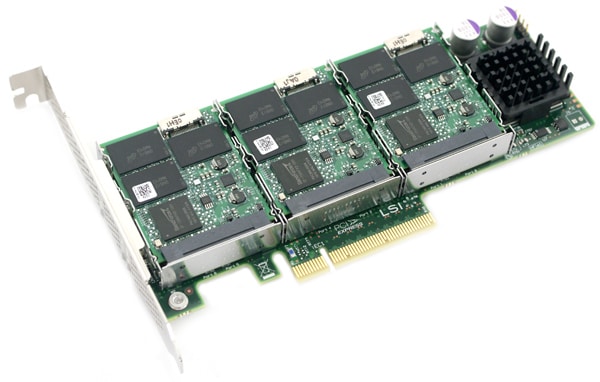
LSI SLP-300 WarpDrive Specifications:
- 300GB storage (384GB of Micron SLC NAND)
- PCI Express 2.0 host interface
- ECC protection up to 24 bits per 512 bytes
- LSI SAS2008 Controller
- Simpler integration using SAS infrastructure
- Enterprise reliability
- Up to 240K 4K Read IOPs
- Up to 200K 4K Write IOPs
- Average latency of less than 50 microseconds
- Powered entirely by the PCIe slot, consumes <25 Watts
- Supports Windows and Linux operating systems
Aesthetics
The LSI WarpDrive SLP-300 doesn’t look much different than your average RAID controller, besides for the fact that it is carrying 300GB of SLC memory on six small daughter-boards. The device itself is a half-height PCI Express 8x card offering dual mounting options for full-size or smaller slots depending on server height.
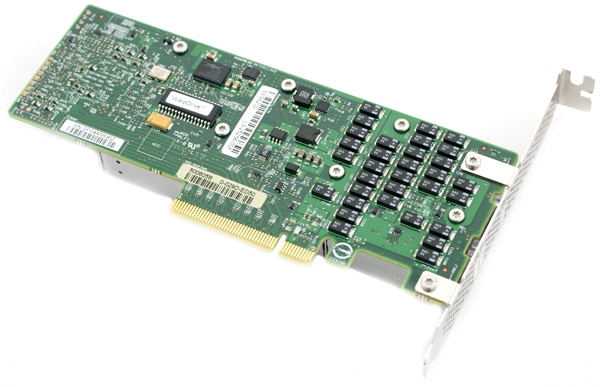
The bulk of the WarpDrive by far are the six small SF-1500 powered enterprise-class SSDs connected in pairs to the controller. The only remaining component on the front of the card is the LSISAS2008 controller which is covered by a mid-sized passive black heatsink.
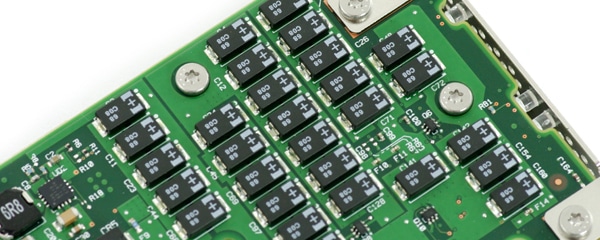
The back of the WarpDrive includes a few serial number and model number stickers, as well as the flash memory for the onboard BIOS as well as an array of capacitors to stabilize incoming power. It’s really hard to imagine how something so small could be so expensive – but good things do come in small packages.
Disassembly
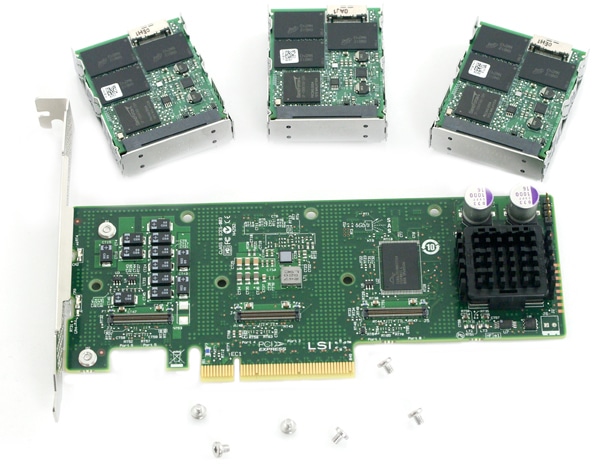
I have to admit that taking apart an enterprise-grade SSD that retails for nearly $10,000 did make me think twice about what I was doing. Every small connector that had to be popped off was painstakingly disconnected to not break the seemingly fragile ribbon cables connecting each individual SSD to the main controlling board.
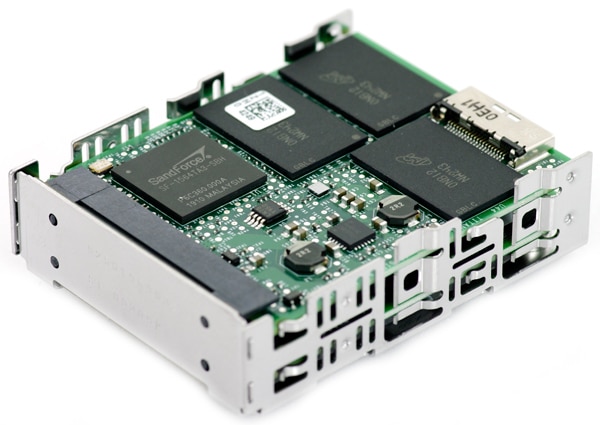
The card has three primary sections; the controller board, the twin SSD banks, and the individual SSD daughter boards. After removing two Torx screws per SSD bank, the boards are fairly easy to remove one you lift them away from the controller board and carefully disconnect a small ribbon cable on the backside of the bank.
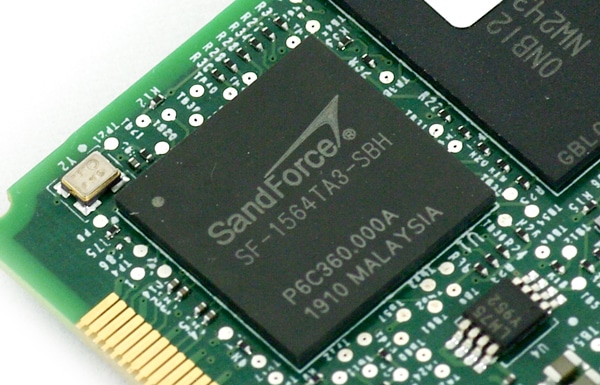
Each SSD includes one SandForce SF-1564TA3-SBH controller, eight 8GB Micron SLC NAND pieces, and one service port. The individual SSDs each have some over-provisioning enabled, which accounts for the 50GB storage capacity with 64GB of flash onboard.
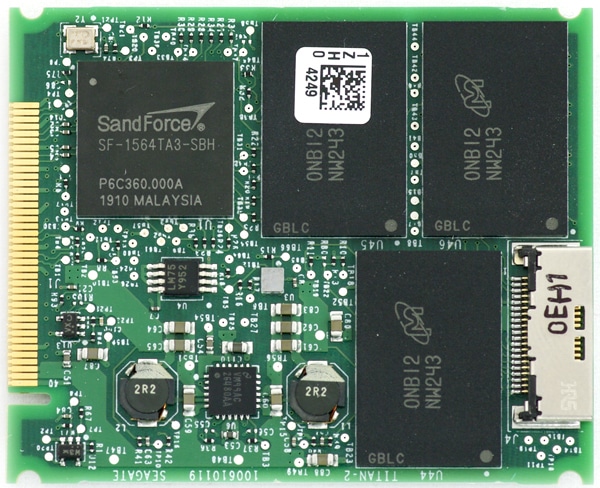
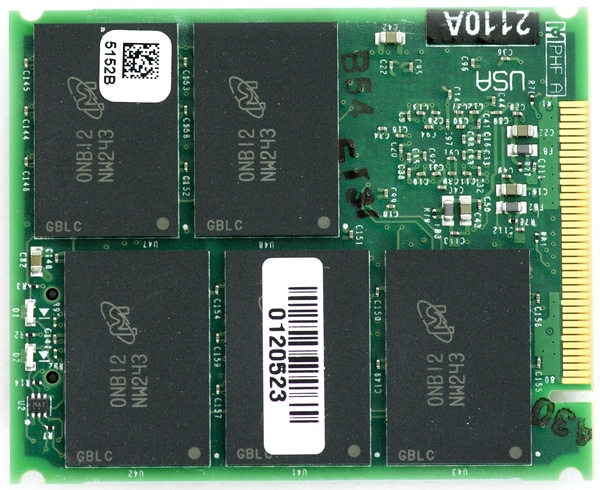
Synthetic Benchmarks
Even though we would like to claim we put the LSI WarpDrive inside some fancy high-end server to put it through its paces, we only had our lowly Dell XPS 9000 for our benchmarking process. It’s kind of funny to think that this single component is valued at 10x the cost of the entire computer. What matters though is this card had an 8x PCI Express slot, which was exactly what the card was rated to perform with. For testing we stuck with our standard suite of benchmarks, although we did expand the random read/write tests since that is where the greatest performance differences are found with this card. Under normal transfer tests with a low queue depth, it might not seem as though the drive is much faster than consumer models, but not let that mistake you for its true potential. What really matters is that this SSD screams while under pressure.
With a queue depth of one in our IOMeter 2MB sequential file transfer test, the WarpDrive almost doesn’t look that special.
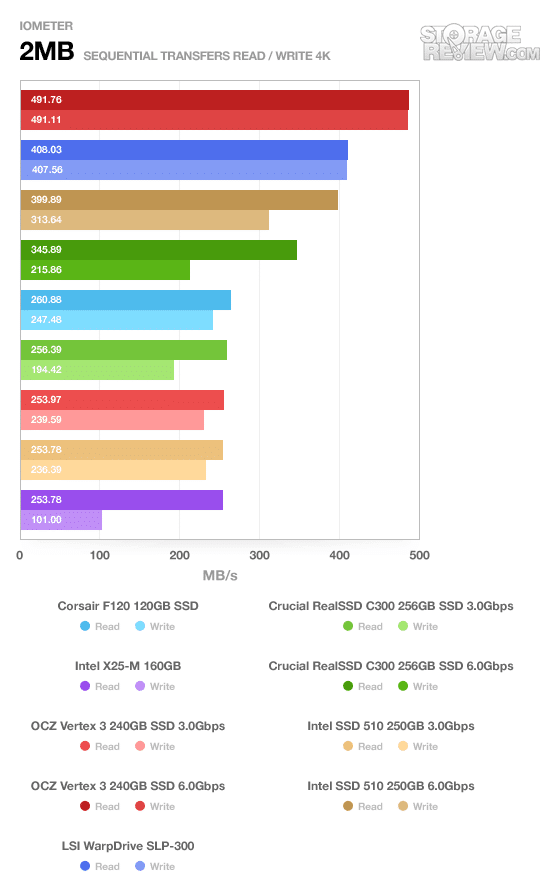
We measured an average read speed of 408MB/s and a write speed of 407MB/s. Both of these scores fall below only the OCZ Vertex 3.
Looking at its random 2MB transfer performance, the results still fail to impress.
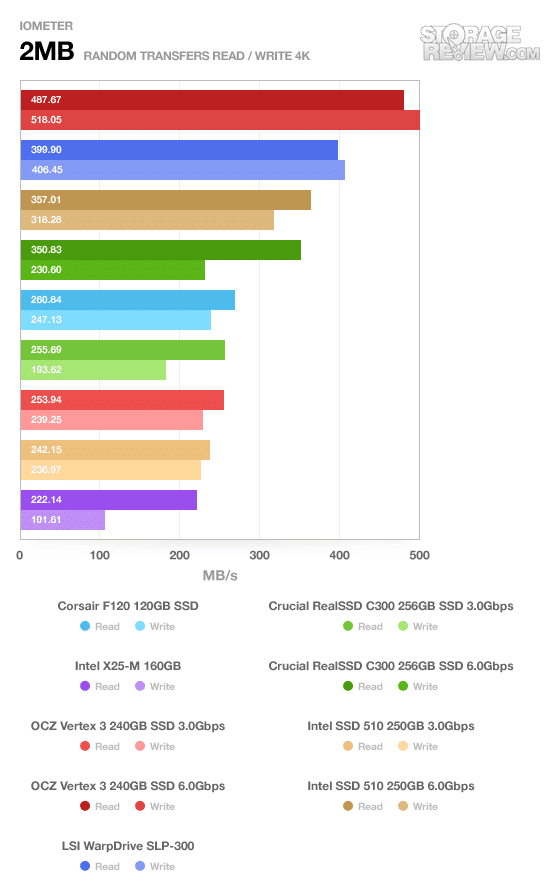
The WarpDrive still came in second compared to the OCZ Vertex 3 over SATA 6.0Gb/s, measuring 400MB/s read and 406MB/s write.
Switching to 4K random transfers, still with a queue depth of 1, the LSI WarpDrive SLP-300 stays in the middle of the pack.
We measured 16.62MB/s read and 70.83MB/s write, which worked out to roughly 4250IOps read and 18100IOps write. The next test is where results start to look very interesting though.
We decided to ramp the queue depth and gauge how well each drive performs in random 4K transfers as loads increase. The results were nothing short of amazing.
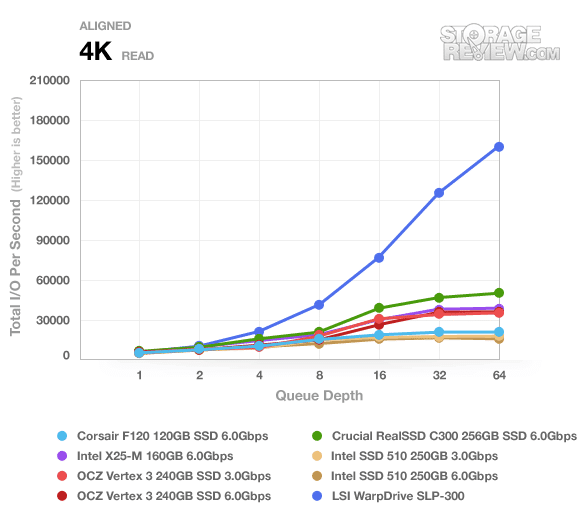
As you can see from the charts, all of the drives rank pretty similar in the queue depths of 1 and 2. As you go beyond that, it’s no contest. It’s almost like racing a Ferrari against the family minivan. While all of the other drive top out between 25,000 to 50,000 IOps, the LSI WarpDrive screams past 150,000IOps 4K read.
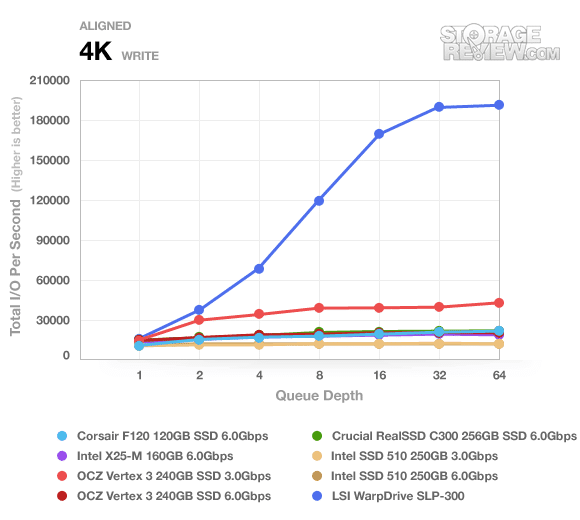
The performance of the WarpDrive gets even better in its random write abilities, this time topping well over 180,000 IOps 4K write. Nothing stands a chance at keeping up.
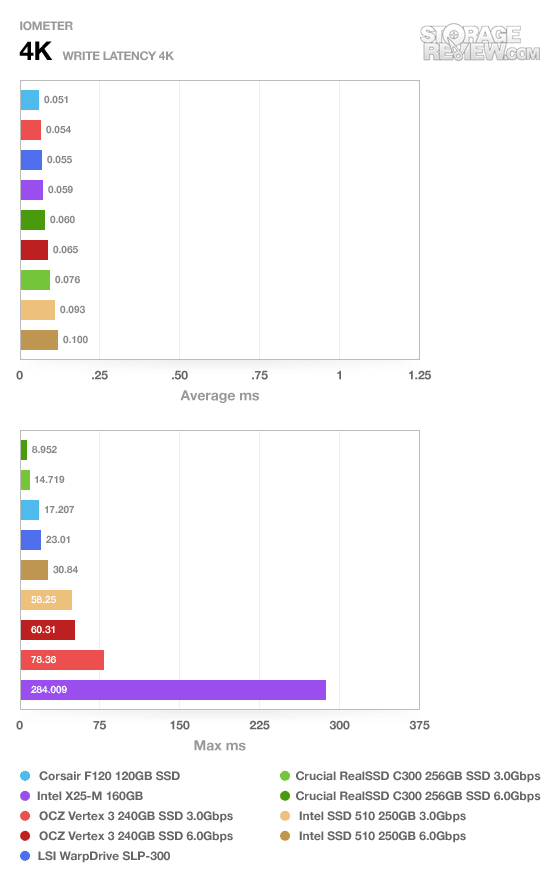
Going back to single queue depths for the 4K write latency test, the LSI WarpDrive SLP-300 has very good results, measuring 0.055ms average with a peak response time of 23.01ms.
CrystalDiskMark, just like our initial IOMeter tests don’t really show the true potential of this drive. In most single queue depth settings, the drive doesn’t really surpass the scores of some high-end consumer SSDs.
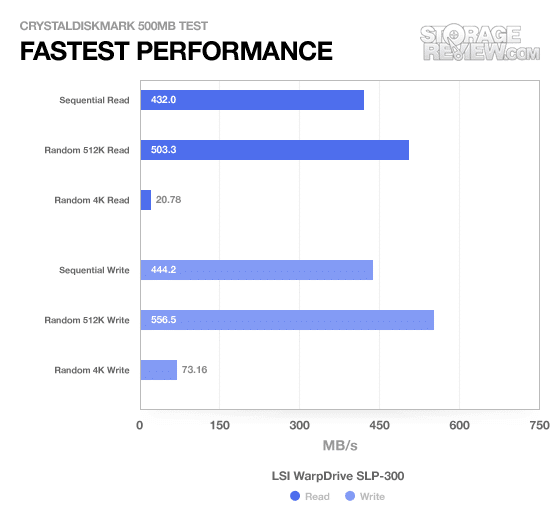
The next group of tests we look at are our IOMeter server profile tests. This is by far the best usage scenario for this drive, considering it is being aimed squarely at the enterprise server market.
The 4K-aligned database test is similar to what a heavily used database would create load wise, and as such is a better representation of the LSI WarpDrive’s abilities than most. The SLP-300 easily outclasses every other consumer SSD, even the Intel 510 by a factor of 10 at 128 I/O’s outstanding, which is nothing short of incredible. The only exception was the Crucial RealSSD C300 SATA 6GB/s, which manages to pull ahead at 1 I/O outstanding.
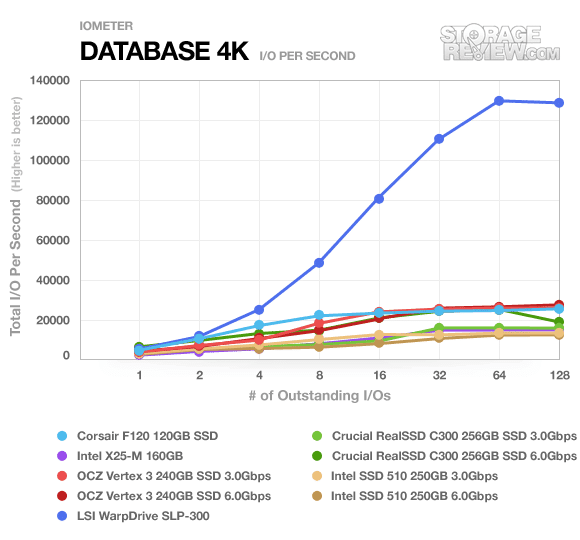
The webserver profile shows the same results, the WarpDrive clearly outclasses every other consumer SSD. The RealSSD C300 managed to once again surpass the Warpdrive during the 1 I/O test.
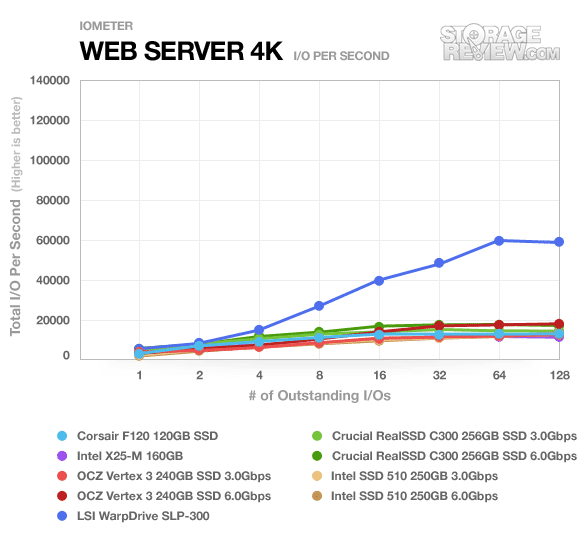
The fileserver test repeats the pattern. The WarpDrive is miles faster than every other SSD, save for the Crucial C300 again at 1 I/O outstanding. Interestingly, the OCZ Vertex 3 3Gbps does come close to the Wardrive at 1 I/O as well.
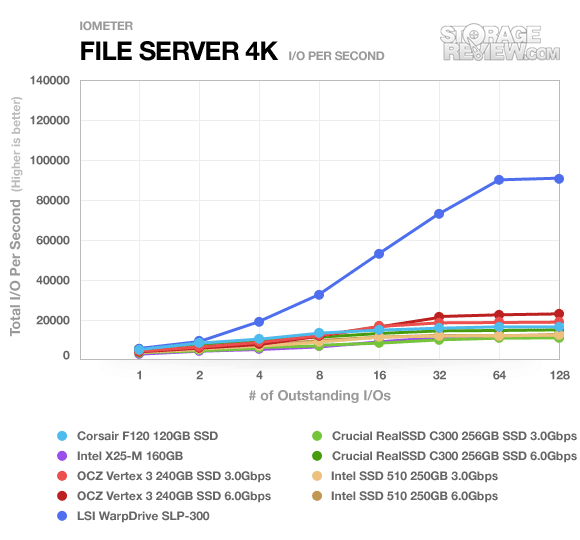
In the workstation benchmark the WarpDrive SLP-300 still holds a commanding lead over all of the other SSD’s in this test, though the Crucial C300 does manage to keep up at 1 I/O outstanding.
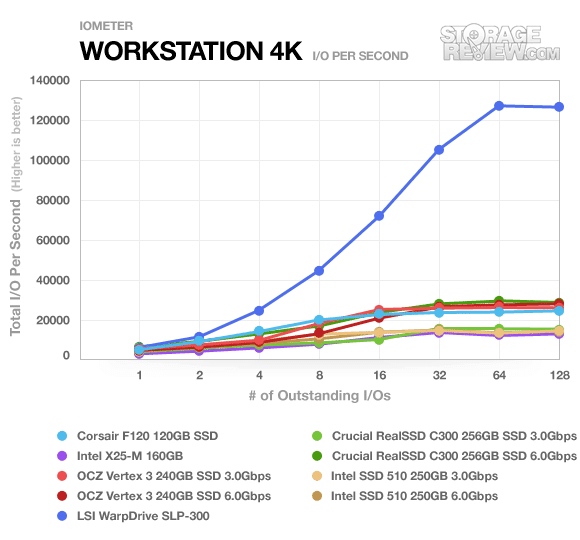
Real-World Benchmarks
If you are new to StorageReview, one thing we try to focus on is how any given drive might perform under real-world conditions. For the average user, trying to translate random 4K write speeds into an everyday situation is pretty difficult. It helps when comparing drives in every setting possible, but it doesn’t exactly work out into faster everyday usage or better game loading times. For this reason we turned to our StorageMark 2010 traces, which include HTPC, Productivity, and Gaming benchmarks to help readers find out how a drive might perform under their conditions.
Since our real-world tests are focused on single-user environments, they won’t show extremely high scores like we found in the IOMeter server profile tests. The main reason for this is lack of high queue depths, which don’t stress the WarpDrive enough to show its true performance. While the scores below do look very impressive, it does show that consumer drives aren’t too far behind in these scenarios. Simply put, don’t buy the WarpDrive for your home PC.
The first real-life test is our HTPC scenario. In this test we include: playing one 720P HD movie in Media Player Classic, one 480P SD movie playing in VLC, three movies downloading simultaneously through iTunes, and one 1080i HDTV stream being recorded through Windows Media Center over a 15 minute period. Higher IOps and MB/s rates with lower latency times are preferred. In this trace we recorded 2,986MB being written to the drive and 1,924MB being read.
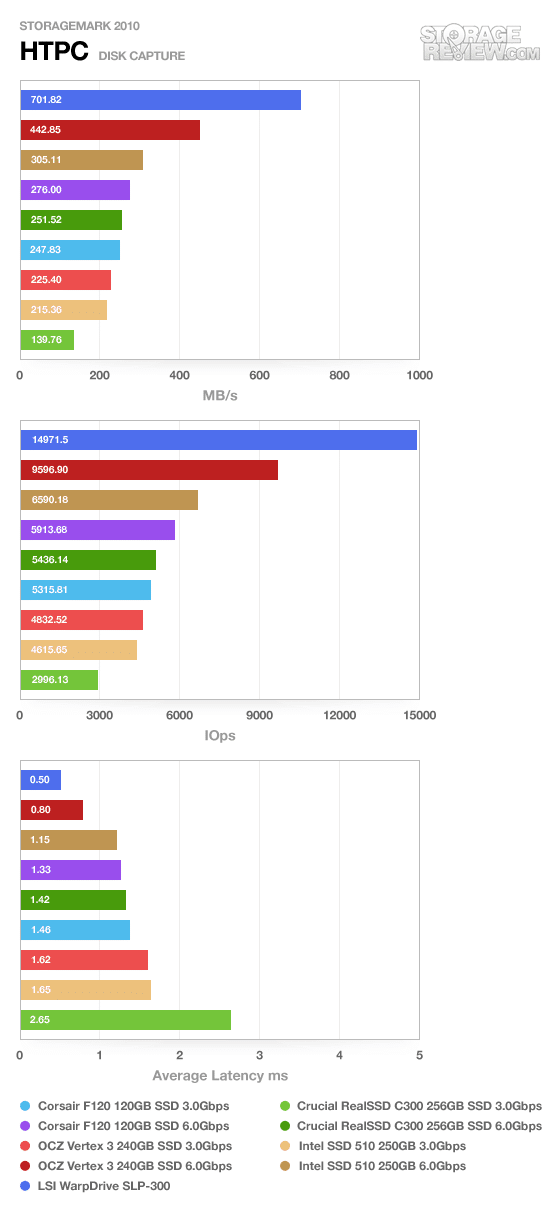
The StorageMark HTPC test shows that the WarpDrive takes the gold with over 703MB/s and 14971.5 IOps with the next in line being the Vertex 3 6Gpbs with 442MB/s and 9596.9 IOps.
Our second real-life test covers disk activity in a productivity scenario. For all intents and purposes this test shows drive performance under normal daily activity for most users. This test includes: a three hour period operating in an office productivity environment with 32-bit Vista running Outlook 2007 connected to an Exchange server, web browsing using Chrome and IE8, editing files within Office 2007, viewing PDFs in Adobe Reader, and an hour of local music playback with two hours of additional online music via Pandora. In this trace we recorded 4,830MB being written to the drive and 2,758MB being read.
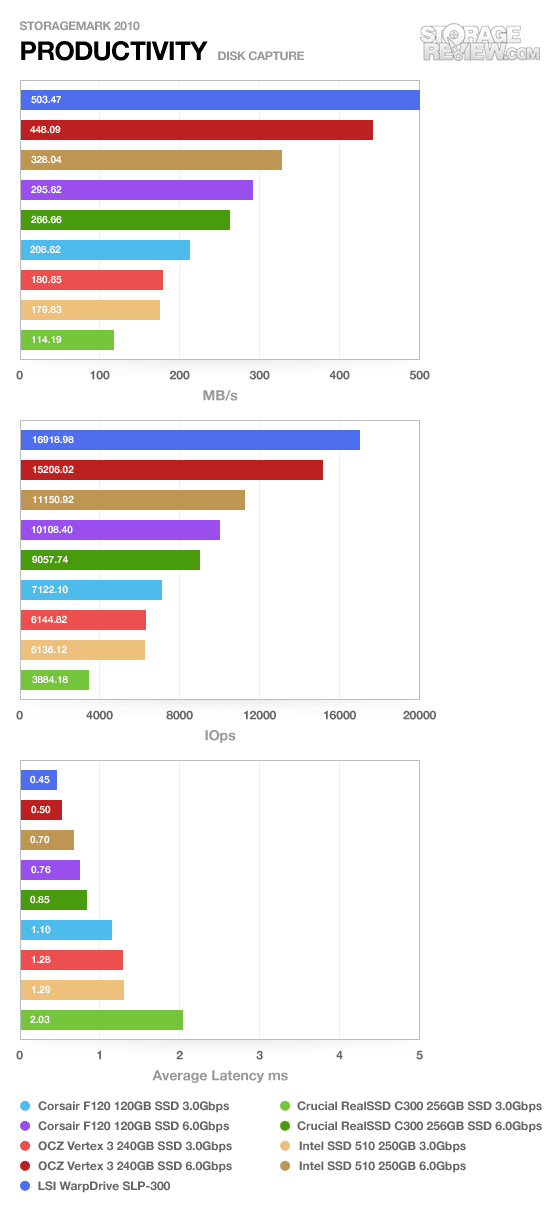
The StorageMark Productivity test shows the WarpDrive still leads the pack with 503MB/s, but the Vertex 3 6Gpbs is right behind it with less than 60MB/s between them.
Our third real-life test covers disk activity in a gaming environment. Unlike the HTPC or Productivity trace, this one relies heavily on the read performance of a drive. To give a simple breakdown of read/write percentages, the HTPC test is 64% write, 36% read, the Productivity test is 59% write and 41% read, while the gaming trace is 6% write and 94% read. The test consists of a Windows 7 Ultimate 64-bit system pre-configured with Steam, with Grand Theft Auto 4, Left 4 Dead 2, and Mass Effect 2 already downloaded and installed. The trace captures the heavy read activity of each game loading from the start, as well as textures as the game progresses. In this trace we recorded 426MB being written to the drive and 7,235MB being read.
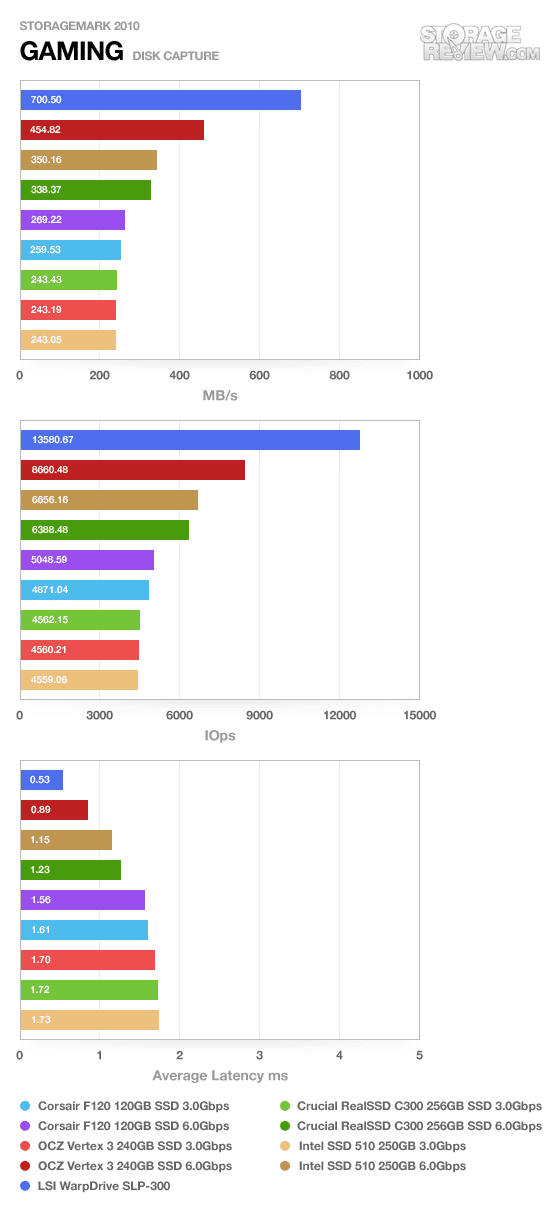
The StorageMark Game test shows the WarpDrive with a 30% lead over all the other SSD drives with 700MB/s, compared to the Vertex 3 6Gbps with 454MB/s.
Power Consumption
Being a very unique form-factor, we couldn’t test the power consumption of the LSI WarpDrive SLP-300 like we could normal drive. Given the enterprise market and the large disk arrays this SSD competes against, the rated power consumption is still a fraction of the other options. The SLP-300 is powered entirely off the PCI-Express slot, with a maximum rated power consumption of under 25 watts.
Warranty
LSI stands behind the WarpDrive SLP-300 with a three-year warranty. While this might seem low compared to consumer drives that offer the same length, you need to remember that this drive will see orders of magnitude more data flow through it over its life than the average 2.5-inch MLC-based SSD.
Conclusion
The LSI WarpDrive SLP-300 is designed with one goal in mind; have incredibly fast random read/write speeds at with demanding workloads. If you compare this drive under “normal” workloads, it performs well, but even high-end consumer SSDs like the OCZ Vertex 3 can slip past it. While quick with a bit over 400MB/s read in our 2MB sequential write test, it doesn’t really show off how this drive can handle queue depths that most drives start to choke under. In the right conditions, this drive is exponentially faster than the fastest consumer SSD. Comparing this drive in our ramped 4K read/write test and our IOMeter server profile tests to single SSDs is night and day. Nothing comes close.
With a price tag close to $10,000, this drive isn’t for everyone. For its intended audience this card replaces huge storage arrays that compete on the same IOPs level with something that can fit in a half-height card slot. For that price you get 384GB of Micron SLC NAND (300GB which is usable after over-provisioning) powered by six SandForce SF-1500 controllers all routed through a 533MHz PowerPC-based LSI SAS2008 RAID controller.
Pros
- Fly past SSDs like they are standing still at high workloads
- Able to fit in small servers with its smaller form-factor
- No external power hookups needed
Cons
- Way out of my desktop budget
Bottom Line
If you need the fastest possible solid-state solution, the LSI WarpDrive SLP-300 is the drive of choice. Designed and priced for the enterprise market, the WarpDrive delivers incredible performance in a small half-height PCI-Express card.


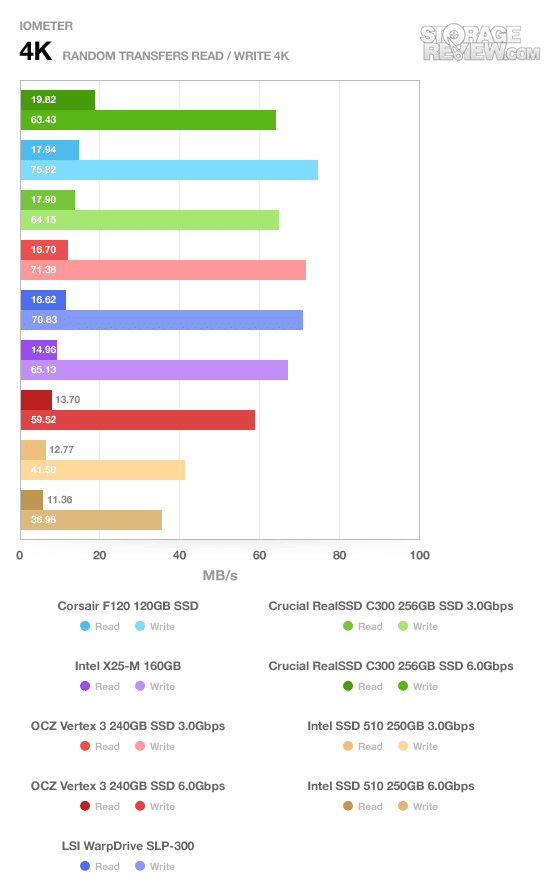
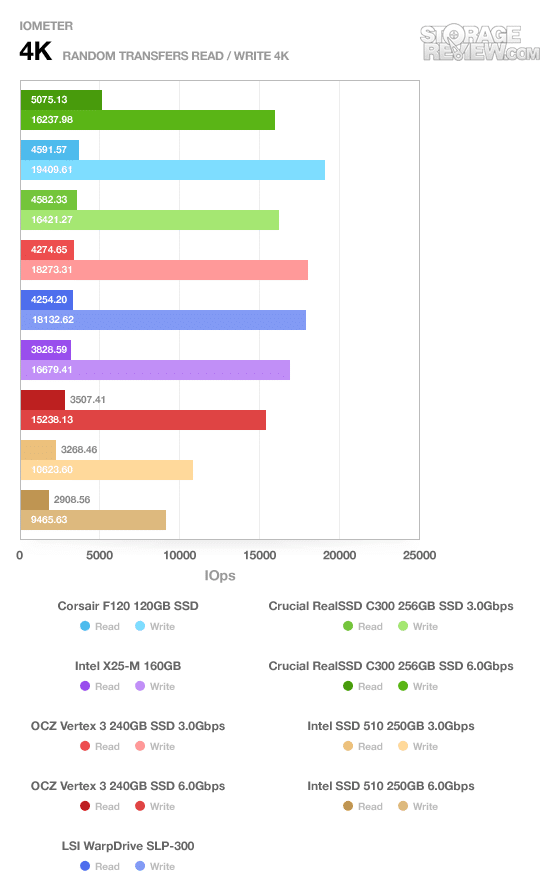


 Amazon
Amazon